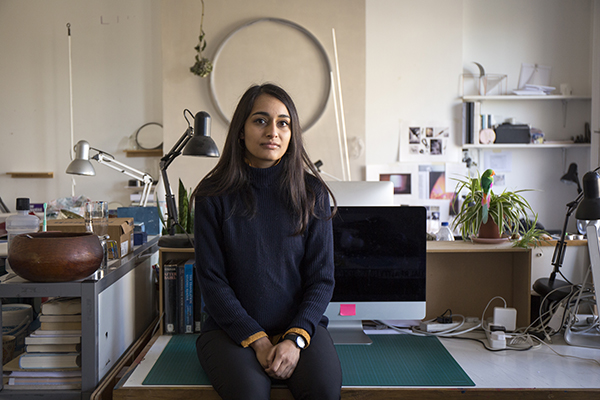Over the past year we worked with a group of students and staff at the world-renowned Royal College of Art in London to develop a series of sonic design experiments, pushing the envelope of sound design and communication.
Learning to Listen: Sarah Sajid
Over the past year we worked with a group of students and staff at the world-renowned Royal College of Art in London to develop a series of sonic design experiments, pushing the envelope of sound design and communication. Listen and find out more below. Check out the full collection here.
| CONTRIBUTORS |
| Photos: Clayton Cavender |
Tell us about your background?
I am a first generation British Asian practitioner and increasingly I think about the narratives between these opposing cultures that I come from and my work responds to the conflicts of this. I explore identity and am inspired by language, duality, miscommunication and a sense of belonging. In London it is commonplace to be surrounded by people who possess three, four, or five cultures and I want my sound to speak to them. When listening to my work, I want the listener to find a familiarity however strange or disconnected that is.
What inspired you to work with sound?
I find sound is an immediate, unavoidable, visceral medium that people either connect with or somehow respond to. I use sound to describe things I could not describe using words or images.
What is the concept behind your project and how did you make it?
I am fascinated by the notion that two things can come together and make something new. In the same way that my two cultures form something different, confusing even, binaural beats do just that. Though this phenomenon is not new, its existence is a metaphor for how I feel. The crackling sound interspersing the track is a playful field recording of physical reactions when two materials are put together – i.e. baking soda and vinegar. I have then processed these recordings to further divide our association of the physical reality.
What have you learnt from listening to the world more closely?
I recently did a ‘nightwalk’, which entailed hiking in the Lake District in the darkness. I found that I relied entirely on my hearing to navigate my way through the terrain. Whether it was marshland or wet slate I could only hear the person in front of me to know what to expect. I realised that we create an entire language of sounds that we innately understand in order to perceive the external world. I think that both the real and fictitious sound that envelops us is vital in our experience of the world.





